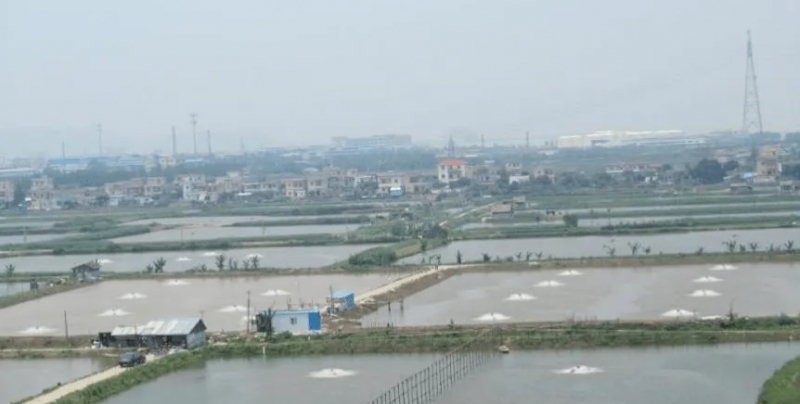News
How much do you know about dissolved oxygen in aquaculture ponds?

It is well known that dissolved oxygen is the soul of aquaculture, and the fluctuation of dissolved oxygen index also indirectly feeds back the status of various indicators of water body. Next, let's talk about the relationship between dissolved oxygen and aquaculture.
Source of dissolved oxygen in water
The dissolved oxygen in the water mainly comes from the photosynthesis of algae and aquatic plants in the water. Strictly speaking, oxygen is a by-product of the carbon reduction process of photosynthesis. CO2+H2O→CH2O+O2。 More than 60% of dissolved oxygen in water comes from algae, which requires the necessity of reasonable cultivation of algae in the process of aquaculture
Oxygen permeation in the atmosphere
Such as wind blowing, roots blower, aerator, water flow, etc
Consumption of dissolved oxygen
The consumption of dissolved oxygen in the water body mainly depends on the respiration of algae, aquatic plants, breeding objects and microorganisms in the water body, and the decomposition of organic matter in the residual bait feces at the bottom of the pond.
Hazards of excessive dissolved oxygen
Too high dissolved oxygen will lead to too high oxygen pressure in the water body, and too high oxygen pressure will cause "oxygen poisoning" to the breeding animals, especially the breeding objects of the larvae, which will cause bubble disease. At the same time, generally speaking, too high dissolved oxygen indicates that the amount of algae in the water body is too large and the distribution of algae phase is not normal, so it is easy to pour algae under such weather conditions. A large number of free radicals can be produced under high dissolved oxygen, which has a harmful effect on many organs of the cultured object. In the environment of high dissolved oxygen, the metabolism of new algae is accelerated, which is easy to cause the rapid aging of algae, accelerate the death of algae, lead to the rapid hypoxia of aquaculture ponds, and cause the death of cultured animals
Hazards of insufficient dissolved oxygen
Insufficient dissolved oxygen can affect pond culture from both animal and environmental aspects
Animal aspect
① Direct death. When the dissolved oxygen is lower than the minimum tolerated concentration of cultured animals for a period of time, it can directly lead to the suffocation and death of cultured animals.
② Non fatal injury. When fish and shrimp are seriously anoxic for a short time, they will not die, but they will also be seriously injured.
③ Impaired immune function. In the low dissolved oxygen environment, the immune function will be damaged, and it will become more sensitive to the invasion of pathogenic microorganisms.
④ The ability to resist adversity decreases. The lack of dissolved oxygen can cause the farmed animals to become more sensitive to environmental change conditions such as pH change, temperature change and salinity change.
⑤ The efficiency of digestion and absorption decreases. The digestibility and assimilation ability of fish and shrimp to feed is directly proportional to the dissolved oxygen concentration. The higher the concentration of dissolved oxygen in a certain range, the higher the ability of digestion, absorption and assimilation. Therefore, the oxygen demand of the pond will increase with the decrease of dissolved oxygen concentration.
Environmental aspects
① Resulting in changes in microbial ecological composition. Microorganisms in nature are distributed in a redox gradient. The microorganisms adapted to different rongo concentrations were different. Therefore, changes in dissolved oxygen concentration will lead to changes in microbial population.
② Resulting in increased oxygen demand in the pond. The low dissolved oxygen leads to the decrease of digestion and absorption capacity of fish and shrimp, resulting in more waste of feed, so more dissolved oxygen is needed for treatment.
③ Resulting in a decrease in pollution purification capacity. The rate of microbial oxidation of organic matter is directly proportional to the concentration of dissolved oxygen. The low dissolved oxygen concentration increases the pollution rate on the one hand and reduces the purification speed on the other. Therefore, the low dissolved oxygen will easily cause the rapid accumulation of pollutants and greatly reduce the pollution bearing capacity of the pond. Causing degradation, aging and deterioration of water quality.
④ Resulting in an increase in pathogenic microorganisms. Almost all pathogenic microorganisms of aquaculture animals are facultative anaerobes.. When dissolved oxygen is insufficient, aerobic microorganisms lose their competitive advantage and facultative anaerobic microorganisms gain opportunities.
⑤ Resulting in an increase in toxic and harmful substances. Low dissolved oxygen will lead to the production of reducing substances such as hydrogen sulfide, ammonia nitrogen, sulfite and other harmful substances.
Welcome to contact:+8618013418091(Whatsapp/Wechat)
+8618013418097(Whatsapp/Wechat)
 Alvin
Alvin hugh778
hugh778